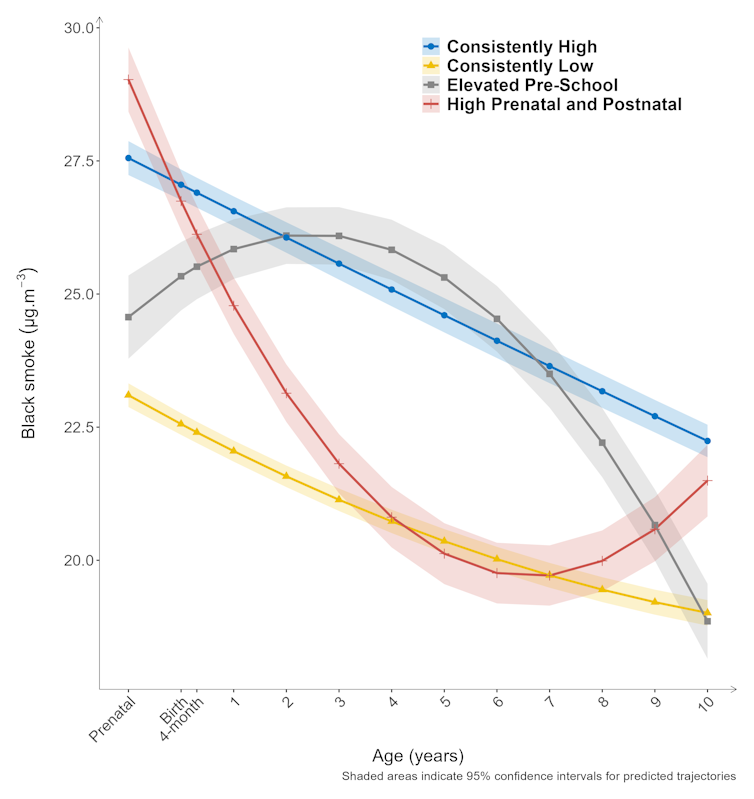Early exposure to air pollution could affect brain development and mental health later in life: new research – The Conversation

Exposure to Air Pollution and its Impact on Child Development and Mental Health in Adolescence
A recent study has revealed that early-life exposure to air pollution can have lasting effects on child development and mental health in adolescence. The study, which integrated air pollution data with existing longitudinal data from the Christchurch Health and Development Study (CHDS), highlights the long-term consequences of growing up in polluted environments.
Sustainable Development Goals (SDGs) Addressed:
- SDG 3: Good Health and Well-being
- SDG 4: Quality Education
- SDG 11: Sustainable Cities and Communities
- SDG 13: Climate Action
Background
The CHDS has been following over 1,200 children born in Christchurch in 1977, with a focus on developmental and mental health outcomes. The aim of this study was to examine how exposure to air pollution during childhood and adolescence affects development and mental health. The researchers found that higher exposure to air pollution was associated with an increased risk of attention problems, conduct issues, lower educational attainment, and substance abuse in adolescence.
Air pollution is a leading environmental contributor to respiratory and cardiovascular conditions, making children especially vulnerable due to their developing brains and bodies. Growing evidence suggests that air pollution can affect brain development, educational attainment, and mental health, contributing to depression, anxiety, and conduct or attention problems. However, few studies have tracked long-term exposure to air pollution from early childhood.
Patterns of Exposure
The research was conducted in Christchurch, a historical air-pollution hotspot, with a documented history of measurements and a long-running birth cohort study. The CHDS collects detailed information on participants’ health, development, education, and family backgrounds from prenatal into adulthood.

For this study, historical air-pollution data from 1977 to 1987, measured as the concentration of black smoke, was linked to the residential locations of birth cohort members. This allowed researchers to estimate each child’s annual exposure to air pollution during key developmental periods. Four distinct patterns of air-pollution exposure across childhood were identified:
- Consistently low
- Consistently high
- Elevated preschool
- High prenatal and postnatal
The study examined whether children in the higher exposure groups were more likely to experience adverse impacts on cognition, educational achievement, and mental health in later childhood and adolescence. The researchers adjusted for potential confounders such as socioeconomic status, neighborhood disadvantage, and parental characteristics.

Findings and Implications
While the effects of air pollution on individual outcomes were small, they could have significant consequences at a population level. Even small shifts in cognitive and mental health outcomes, when applied to entire populations of children exposed to poor air quality, can have major implications for future educational achievement, workforce productivity, and public health burdens.
The findings support previous research indicating that air pollution can affect brain function through inflammation, oxidative stress, and neurodevelopmental pathways. They also highlight the sensitivity of certain developmental periods, such as the prenatal period and early childhood, to pollution exposure.
To address these findings, it is crucial to reduce children’s exposure to air pollution and improve urban air quality by reducing emissions from vehicles, industry, and residential heating. Promoting cleaner energy sources and providing better access to green spaces can also mitigate the impact of air pollution.
Stricter air quality regulations, particularly around schools and childcare centers, should be implemented to strengthen public health and policy measures. Additionally, air-quality monitoring in urban areas can help identify high-risk zones for children.
Public information campaigns are essential to minimize indoor and outdoor pollution exposure. Measures such as using air purifiers for indoor activities or limiting outdoor exposure during peak pollution periods can be effective strategies.
Further Research and Action
This study emphasizes the need for more research on the effects of air pollution on children’s mental health and cognition, particularly in different environmental and socioeconomic contexts. Policymakers, educators, and healthcare professionals should consider air pollution as a potential risk factor for developmental challenges, not just a physical health concern.
Air pollution may not be as visible as poor housing or inaccessible healthcare, but its impact on child development can be significant at a population level. Tackling air pollution should be recognized as an essential public health strategy for protecting future generations, given the rising prevalence of mental ill health in young people and adults.
SDGs, Targets, and Indicators
| SDGs | Targets | Indicators |
|---|---|---|
| SDG 3: Good Health and Well-being | Target 3.9: By 2030, substantially reduce the number of deaths and illnesses from hazardous chemicals and air, water, and soil pollution and contamination | Indicator not mentioned in the article |
| SDG 4: Quality Education | Target 4.1: By 2030, ensure that all girls and boys complete free, equitable, and quality primary and secondary education | Indicator not mentioned in the article |
| SDG 11: Sustainable Cities and Communities | Target 11.6: By 2030, reduce the adverse per capita environmental impact of cities, including by paying special attention to air quality and municipal and other waste management | Indicator not mentioned in the article |
| SDG 13: Climate Action | Target 13.2: Integrate climate change measures into national policies, strategies, and planning | Indicator not mentioned in the article |
| SDG 15: Life on Land | Target 15.9: By 2020, integrate ecosystem and biodiversity values into national and local planning, development processes, poverty reduction strategies, and accounts | Indicator not mentioned in the article |
1. Which SDGs are addressed or connected to the issues highlighted in the article?
SDG 3: Good Health and Well-being
The article discusses the long-term effects of air pollution on child development and mental health in adolescence. This is directly connected to SDG 3, which aims to ensure good health and well-being for all.
SDG 4: Quality Education
The article highlights the impact of air pollution on educational attainment and cognitive development in children. This aligns with SDG 4, which focuses on providing quality education for all.
SDG 11: Sustainable Cities and Communities
The article mentions the need to improve urban air quality and reduce emissions from vehicles, industry, and residential heating. This relates to SDG 11, which aims to make cities and human settlements inclusive, safe, resilient, and sustainable.
SDG 13: Climate Action
The article emphasizes the importance of reducing air pollution and cutting emissions to improve air quality. This aligns with SDG 13, which focuses on taking urgent action to combat climate change and its impacts.
SDG 15: Life on Land
The article does not directly address SDG 15, but it indirectly relates to the goal by highlighting the impact of air pollution on the environment and biodiversity.
2. What specific targets under those SDGs can be identified based on the article’s content?
Target 3.9: By 2030, substantially reduce the number of deaths and illnesses from hazardous chemicals and air, water, and soil pollution and contamination
The article discusses the adverse effects of air pollution on child development and mental health, highlighting the need to reduce the negative health impacts of air pollution.
Target 4.1: By 2030, ensure that all girls and boys complete free, equitable, and quality primary and secondary education
The article emphasizes the impact of air pollution on educational attainment and the need to provide quality education for all children, regardless of their exposure to air pollution.
Target 11.6: By 2030, reduce the adverse per capita environmental impact of cities, including by paying special attention to air quality and municipal and other waste management
The article calls for improving urban air quality and reducing emissions from various sources to mitigate the adverse effects of air pollution on child development and mental health.
Target 13.2: Integrate climate change measures into national policies, strategies, and planning
The article highlights the importance of integrating measures to reduce air pollution and improve air quality into national policies and strategies to combat climate change.
Target 15.9: By 2020, integrate ecosystem and biodiversity values into national and local planning, development processes, poverty reduction strategies, and accounts
The article does not directly address this target, but it indirectly relates to the need to protect ecosystems and biodiversity from the harmful effects of air pollution.
3. Are there any indicators mentioned or implied in the article that can be used to measure progress towards the identified targets?
The article does not mention any specific indicators that can be used to measure progress towards the identified targets. However, potential indicators could include measures of air pollution levels, educational attainment, mental health outcomes, and policy actions taken to reduce air pollution and improve air quality.
SDGs, Targets, and Indicators
| SDGs | Targets | Indicators |
|---|---|---|
| SDG 3: Good Health and Well-being | Target 3.9: By 2030, substantially reduce the number of deaths and illnesses from hazardous chemicals and air, water, and soil pollution and contamination | Indicator not mentioned in the article |
| SDG 4: Quality Education | Target 4.1: By 2030, ensure that all girls and boys complete free, equitable, and quality primary and secondary education | Indicator not mentioned in the article |
| SDG 11: Sustainable Cities and Communities | Target 11.6: By 2030, reduce the adverse per capita environmental impact of cities, including by paying special attention to air quality and municipal and other waste management | Indicator not mentioned in the article |
| SDG 13: Climate Action | Target 13.2: Integrate climate change measures into national policies, strategies, and planning | Indicator not mentioned in the article |
| SDG 15: Life on Land | Target 15.9: By 2020, integrate ecosystem and biodiversity values into national and local planning, development processes, poverty reduction strategies, and accounts | Indicator not mentioned in the article |
Source: theconversation.com








